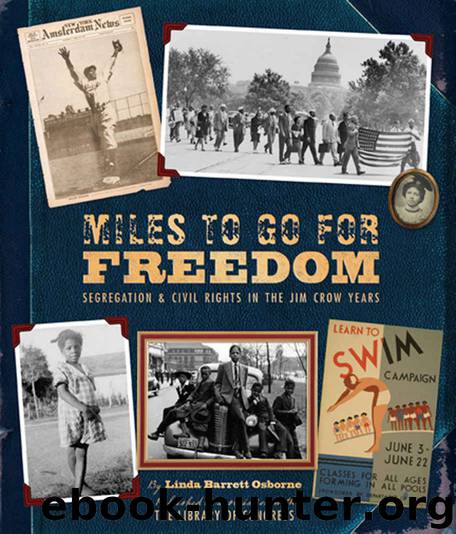Miles to Go for Freedom: Segregation and Civil Rights in the Jim Crow Years by Linda Barrett Osborne

Author:Linda Barrett Osborne [Osborne, Linda Barrett]
Language: eng
Format: epub
Publisher: Harry N. Abrams
Published: 2016-12-20T08:00:00+00:00
The Harlem Renaissance was not just cultural; it was also political. The NAACP kept the public informed about racial issues through its magazine, the Crisis, edited by W. E. B. Du Bois. It reached readers all over the country, even in the South, and was read and discussed in black communities. The National Urban League publication Opportunity Journal, edited by Charles S. Johnson, also championed justice for African Americans and was widely read. These organizations sponsored studies on job and housing discrimination and lynching. The NAACP held mass demonstrations. In 1917, three weeks after a race riot in East St. Louis, Illinois, that killed at least fifty people, ten thousand people marched under the NAACP banner in New York City, in silent protest of the event.
Discrimination and segregation were not only local issues but also national ones. Black activists realized this. The federal government itself practiced segregation beginning in 1913. The armed forces were segregated. Continued efforts to get Congress to pass a national anti-lynching law failed. When African Americans brought their demands to Washington, D.C., they almost always hit a wall. Their experiences raised questions about the commitment of the president of the United States, Congress, and the Supreme Court to ensure civil rights and to provide equal opportunities for all Americans.
Download
This site does not store any files on its server. We only index and link to content provided by other sites. Please contact the content providers to delete copyright contents if any and email us, we'll remove relevant links or contents immediately.
Pale Blue Dot by Carl Sagan(4917)
Cracking the GRE Premium Edition with 6 Practice Tests, 2015 (Graduate School Test Preparation) by Princeton Review(4227)
Pocahontas by Joseph Bruchac(4184)
Unfiltered by Lily Collins(3965)
The Emotionary: A Dictionary of Words That Don't Exist for Feelings That Do by Eden Sher(3318)
The Daily Stoic by Holiday Ryan & Hanselman Stephen(3238)
Factfulness_Ten Reasons We're Wrong About the World_and Why Things Are Better Than You Think by Hans Rosling(3199)
The President Has Been Shot!": The Assassination of John F. Kennedy by Swanson James L(3056)
The 48 laws of power by Robert Greene & Joost Elffers(3031)
Sapiens and Homo Deus by Yuval Noah Harari(2988)
Rogue Trader by Leeson Nick(2980)
The Innovators: How a Group of Hackers, Geniuses, and Geeks Created the Digital Revolution by Walter Isaacson(2849)
Gettysburg by Iain C. Martin(2786)
The Rape Of Nanking by Iris Chang(2777)
Almost Adulting by Arden Rose(2666)
The Plant Paradox by Dr. Steven R. Gundry M.D(2548)
In the Woods by Tana French(2534)
500 Must-Know AP Microeconomics/Macroeconomics Questions(2532)
Make by Mike Westerfield(2291)
